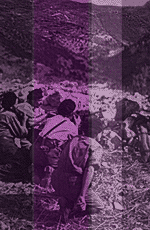

National Resistance
The collapse of state mechanism and of its institutions after the German invasion (April 1941) created deep breaches in the social structure that could not be easily healed over. Faced with this state disintegration, individual citizens took the initiative in auto-organising themselves through new types of social patterns.
The aim thereof was not only the obvious, the resistance to the conqueror, but it also attempted to give answers to the emerging acute problems, the most important issue of which was famine. The unreliable administration of the "collaborators" government, the systematic embezzlement of the country's resources by the Occupation forces and the dramatic aggravation of famine led large and heterogeneous parts of the population to a vast and politically radical mobilisation.
National resistance under its varied forms, whether passive or active, on the mountains or in the cities, through practices of social mutual assistance or the undertaking of armed action, apart from raising traditional political, class and other differences, underlined the resolute refusal of a people to accept the imposed inhuman conditions of living. Resistance in occupied Greece assumed extraordinary proportions and along with the Yugoslavian resistance it became, in the extreme conditions of the Second World War, the most essential mass movement in Europe of the fascist New Order.